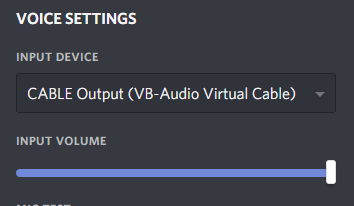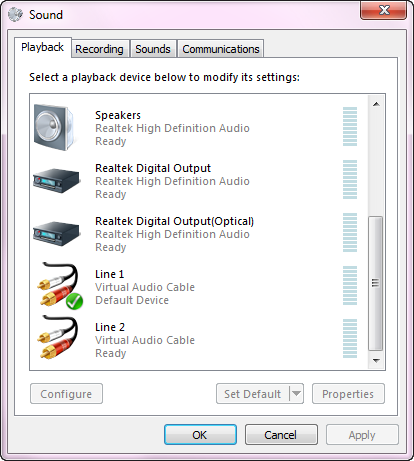

Wife wants to listen, too? Just add "A3" to send Skype sound to headset AND my PC speakers. You guessed right, that's incoming audio from Skype going to my headset. Voicemeeter Aux with "A2" as only output, being my headset (and default communications device under Windows). Voicemeeter Vaio, my default sound device under Windows, for general audio purposes second input is the microphone of my headset, which goes to "B2", the second virtual channel, routing my mike to Skype. Using Voicemeeter allows me to select which input I want to stream to the DAC. I could have used the DAC directly in my audio player, but then again I sometimes want to use the DAC with my AKG K701 connected to it for listening to something else. first input is my VBCable out (yes, you can pipe VBCable into Voicemeeter) for listening to 96kHz audio via my USB ODAC (first hardware output, note the green "A1" button on the first strip).

You can configure a complex matrix of input and output routing, so you could use one virtual channel for Skype (headset mike in/ headset out), another one for SDR, and a third channel for listening to music only, or any combination desired. It is purely for lab and testing purposes.Are you saying that VoiceMeeter totally replaces the Windows audio mixer?Yes, kind of. And to be perfectly clear, this has absolutely nothing to do with the VDI functionality in Lync 2010 or 2013. Connections via Remote Desktop will not work the same way. I should note that this has to be done from the console session of a Hyper-V or VMware VM. You can select Virtual Audio Cable Line 1 for the speaker, and Line 2 for the microphone.Īt this point you can now make and receive phone calls within the VM (although you can’t hear anything!) Now open Lync again and check the Audio Device settings. Right-click on Control Panel and select “Run As Administrator” to open the configuration utility.Įnter 2 for cables and press Set. Navigate to the Virtual Audio Cable folder within the Start Menu.

After the software is installed you can create the virtual audio devices. To get started, unzip the package and run the installation on a VM. This prevents you from testing any audio functionality, which can be handy in a lab to validate Edge server or gateway integration scenarios.Ī solution here is to leverage a tool called Virtual Audio Cable, which offers a free trial available here:

If you use the console or remote desktop on a virtual machine running Lync you’ll see the warning that no audio device is connected:Īnd if you check your Audio Device settings, Lync will tell you that no device has been found. The need to have dedicated PCs each with an audio device for testing Lync audio can sometimes be a challenge, especially in lab environments where all of the clients are virtualized.


 0 kommentar(er)
0 kommentar(er)
